How to Plan a Well-Rounded Spring Garden—Plus 6 Flowers Martha Grows Each Year, According to Her Head Gardener
Plus, tips for planting a beautiful and varied spring garden.

Ryan McCallister
Martha’s flower garden really comes to life during spring. In it, you’ll find flowers of various sizes, colors, shapes, and textures, which add seasonal interest throughout May and beyond. While there are many different types of flowers grown on the farm, there are a few varieties we love to see year after year. Here are some of my and Martha’s favorite spring-blooming varieties, along with a few essential guidelines we keep in mind when planning the flower garden.
Tips for Planting a Successful Spring Flower Garden
There are many ways to create interest in a garden, but these are some of my favorite methods.
Grow a Mix of Perennials and Annuals
In Martha’s garden, you’ll find the perfect ratio of perennials and annuals for her space. Perennials are more work initially, but you’re rewarded with flowers year after year. Some, like roses and peonies, may even last decades, providing numerous flowers over the course of their lifetime.
On the other hand, annuals need to be planted every year, but produce more blooms in a shorter amount of time than perennials. Once they start blooming, they generally don’t stop until they are killed by frost. Since annuals only have about a year to fully complete their life cycles, they often reach the blooming stage quickly and pump out massive amounts of flowers as fast as they can.
Related: The Difference Between Perennials and Annuals, According to Gardening Experts
Aim for Variety
The best way to add interest to a garden is by growing different types and varieties of flowers. Most flowers come in many different colors, heights, textures, bloom shapes, and sizes, which can be used to make the garden interesting. Choose flowers in contrasting colors, or opt for one color and plant numerous shades of it. Use various heights to provide interest and structure.
Incorporate Unique Foliage
While a flower garden is often all about the blooms, foliage can be just as pretty, so make sure to use it to your advantage when planting a mixed garden. Some plants have naturally more beautiful foliage than others. You can remedy this by planting them amongst and with each other so you can disguise unattractive foliage and allow the flowers to shine.
Related: Take a Tour of Martha's Most Beautiful Gardens—and Learn How She Created Each One
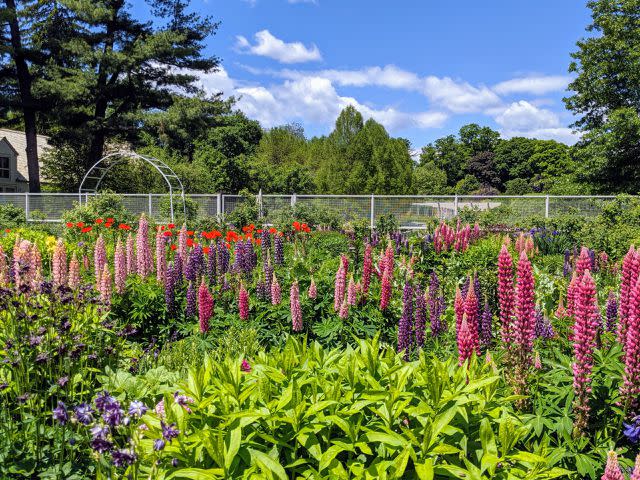
The Martha Blog
Martha’s Favorite Spring Flowers to Grow
Some of Martha’s favorite spring flowers grown on the farm include daffodils, alliums, lilacs, herbaceous and tree peonies, poppies, and lupine. Most of these prefer full sun, though some can tolerate a bit of shade. We grow all of these in zone 7 (formerly zone 5).
Tips
For a healthy, blooming garden, it’s important to fertilize before, during, and after bloom.
Daffodils
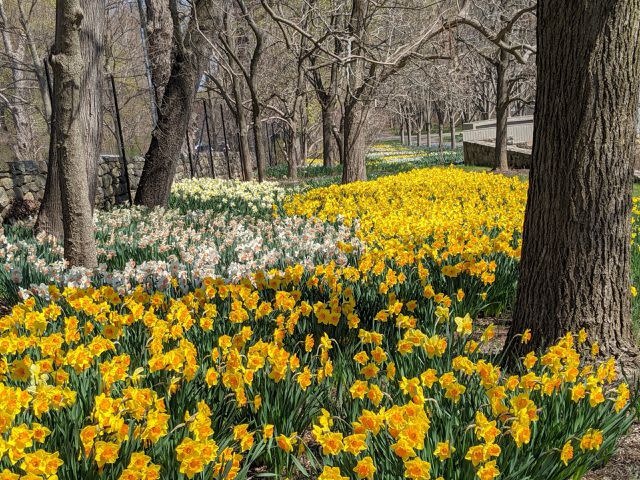
The Martha Blog
Daffodils are a bulb you plant in fall and they bloom the following spring. They tend to multiply year after year, so the patch will slowly increase in size. Daffodils prefer full sun, and generally bloom in shades of yellow, white, pink, and orange. Once planted, they are extremely low maintenance and undemanding.
At the farm, we have them in a huge border running most of one length of the property, as well as in random clumps and patches throughout different areas. After flowering, we leave the foliage to grow for the season, which creates energy for the bulb to store in fall for next year's blooms.
Alliums
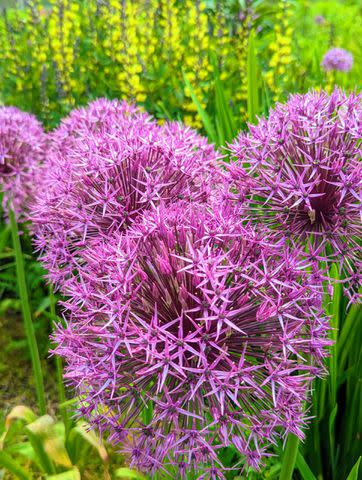
The Martha Blog
Alliums are the ornamental members of the onion family. Most produce spheres of various sizes, composed of numerous small florets, usually in shades of purple (though occasionally white or pinkish). They are great for creating focal points in the garden—especially the large sphered varieties—and add stately structure with their straight stems and round tops.
There is a long winding pergola at the farm filled with alliums of various heights, shades, and bloom times, which we marry with camassia, another bulb blooming before and along with the allium. After blooming, the flower heads of the alliums are often left in the garden to dry on the plant, as they provide some texture and interest. Later on, these may be removed by cutting at ground level to allow for the summer plants, such as lilies, to fill their void.
Lilacs
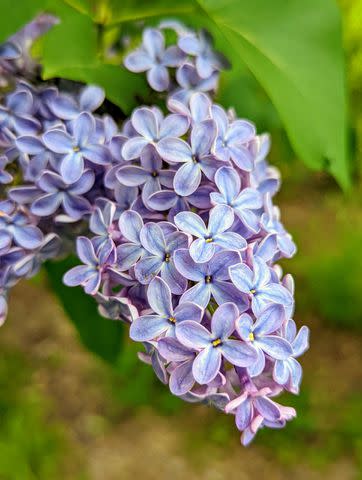
The Martha Blog
Lilacs are medium to large shrubs that typically produce blooms in May at the farm. The flowers are in clusters and come in shades of purple, lilac, lavender, pink, blue, and white. They are extremely fragrant, and make beautiful, though short-lived, arrangements. Lilacs are planted from shrubs, which are generally available in the 5 gallon size. They need a few years to get started and root in, but will provide flowers and fragrance for years to come.
We have a set of parallel double rows of lilac shrubs at the farm, in a range of colors and varieties. The majority of these are at least 8 feet tall, with many being much taller. After blooming, the bushes and their large leaves provide a backdrop and structure in the garden.
Related: How to Grow and Care for Lilacs
Peonies
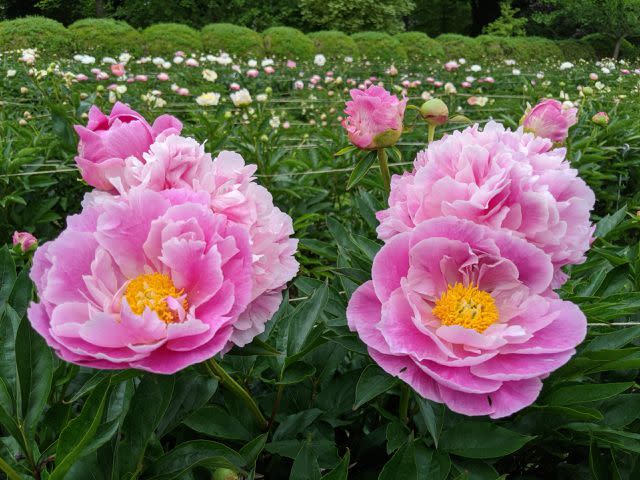
The Martha Blog
Peonies come in a couple different forms. The most readily available type is the herbaceous peony, which is a perennial that grows from a root clump. The clump is dormant during the winter, emerges in spring, and grows through summer before dying down completely in fall. The blooms are some of the largest flowers available for cutting and come in all different shades of pink, red, and white.
We also grow tree peonies on the farm. Instead of dying back each year, they form permanent shrubs that you do not prune back. They bloom a bit earlier and on shorter stems than herbaceous peonies. However, the short-lived flowers are usually larger and come in many more colors, including reds, oranges, yellows, purples, pinks, whites, and bicolors.
We have a large square garden of herbaceous peonies arranged in rows for cutting. The tree peonies are in an elongated landscape bed nearby and are grown more for viewing than for cutting.
Related: How to Grow and Care for Peonies to Ensure Beautiful Blooms Year After Year
Poppies
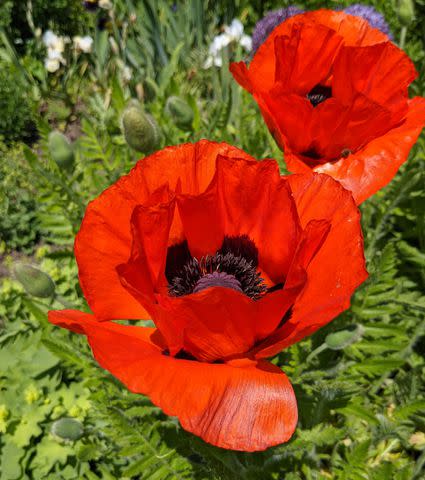
The Martha Blog
There are many varieties of poppies to choose from, though the main two types we grow are Oriental poppies and Breadseed poppies. Oriental poppies are fuzzy-leaved perennials that bloom in May. They die back to the ground each year, but are one of the earliest perennials to emerge, and have attractive foliage even when not blooming. While they come in a number of colors, the bulk of the ones we grow are a bright vermillion orange color.
We also grow all different types of Breadseed poppies and their hybrids. These come in various colors, combinations, flower forms, and shapes—even blooms on the same plant can have different forms. They are often puffy and shaggy with thin, papery petals, but the petal count ranges drastically depending on the type. Varieties like French Flounce, Laurens Grape, and Amazing Grey are some of our favorites.
Breadseed poppies are planted from their dust-like seeds, either strewn out over a light snow in late winter or when they have been allowed to self seed wherever they wish. They generally bloom in late May and June and range from annuals to short-lived perennials. Bees and other pollinators absolutely love Breadseed poppies. The sometimes fragrant blossoms are usually covered by bees all day long.
Lupine
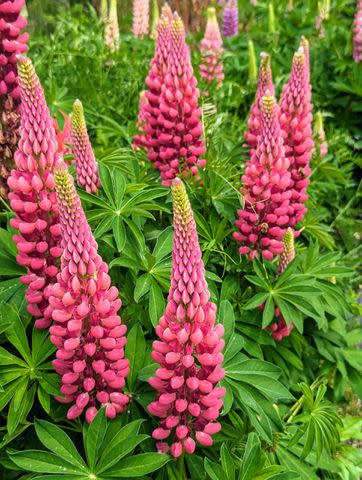
The Martha Blog
Lupine, which usually blooms in May, is a picky flower that has a reputation for being somewhat difficult to grow. Not every year is a good lupine year, it’s usually every second or third year, but when they’re good they’re amazing. They are short lived perennials, but they do self-seed where they are happy. They come in numerous colors and combinations, though the majority of them are shades of pink and purple, with the occasional yellow, white, or bicolor.
I generally let them self-seed outside to establish clumps and patches, while also starting them from seed indoors to refresh and replenish the crop. They produce tall spires of flowers, adding structure and height to the flower garden. They are extremely showy and are one of the flowers that visitors are most amazed with when they are in full bloom. While they can be used as a cut flower, we generally just let them do their thing in the garden.
Related: 15 Flowers to Plant in Spring That Will Fill Your Yard With Color and Fragrance
Read the original article on Martha Stewart.

